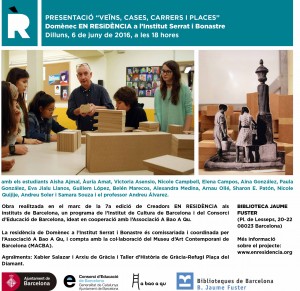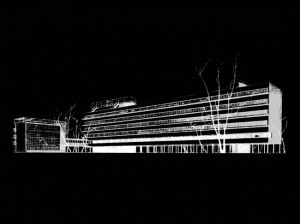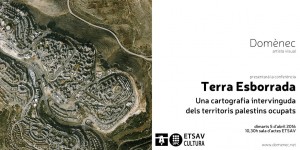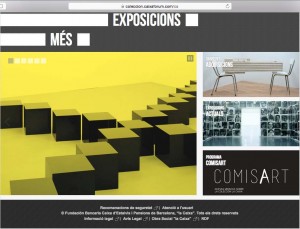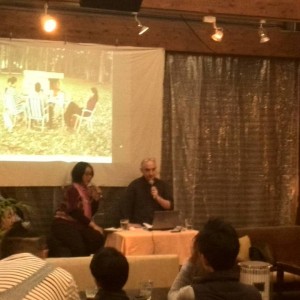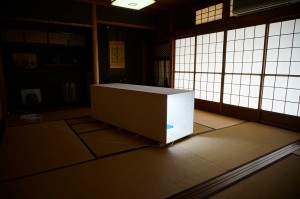Dilluns, 6 de juny de 2016, a les 18 hores
Biblioteca Jaume Fuster
Plaça Lesseps, 20-22 08023 Barcelona
“Arquitectura Española, 1939-1975” at the MUME
Dom Kommuna
Domènec
Dom Kommuna. Manuales de arquitectura doméstica para la vida en común
ADN PLATFORM
A partir del 28 de mayo
Sant Cugat del Vallès
Erased Land
Conversation Piece: Narkomfin, “La Caixa” Contemporary Art Collection
Avant-garde architecture in Barcelona. The art and design of GATCPAC
Wednesday, 13 April 2016
Fundació Joan Miró
19.00 Presentation of the guide map Arquitectura d’avantguarda a Barcelona. Josep Lluís Sert i el GATCPAC by El globus vermell
19.30 Irena Visa, presentation of her photography project at the Casa Bloc
19.50 Break
20.00 Domènec, artist specialising in modern architecture
Lecture in Community Cafe Pangea
Sakai Shelter
Myohoji Temple, Sakai (Osaka), Japan. 2016
Wood, fluorescent light, plastic sheet, several objects.
182 x 66 x 60 cm.
‘no jyuku sha’
There seem to be about 25 000 homeless people in Japan. Some of them describe themselves as ‘no jyuku sha’ or ‘field campers’ – as they manage to settle in parks and other public spaces on a more permanent basis, easily distinguishable by their tent houses made of stark blue plastic covers.
Especially in Osaka, these ‘campers’ not only organize themselves increasingly over the internet, they also engage in political activities to stand up for their rights and protest against the increasing park clearings by the municipality.
Sakai Shelter was part of Sacay Arte Porto.
Produced by Sakai Art Project.
Acknowledgments: Akane Asaoka, Kengo Shibatsuji, Takeshi Nakamura, MyohojiTemple, Community Cafe Pangea.
Sakai Shelter
Models. On Dom Kommuna. Domestic architectural manuals for coexistence / Martí Peran
(Text for the solo exhibition at ADN Platform. May 2016)
At the end of the 1970s, when the habitational utopias derived from the Letter of Athens (1942) sink into the metropolitan peripheries worldwide, Roland Barthes dictates the course How To Live Together in the Collège of France¹. According to the author, the communal ideal lies in the idiorhythm, a “regularly interrupted loneliness” that allows small groupings among individuals to stay together in a precarious balance between mutual distances and proximities. This daydream -barely outlined in practice by Mount Athos’ monks- does not enjoy any societal vocation. The ideal of a good life has nothing to do with phalanxes or other communal models. It in fact defines itself through excluding terms, because it is about not being too far away from others.
Roland Barthes’ ideas express an irregularity that cancels the prolific history of a “being together” enlightened by mass utopias. On the one hand, the idiorhythm acknowledges its genealogy in the anchorit tradition and in some of the multiple cult attempts at utopian socialism. On the other, it dissociates itself from another grand narrative, promoted by Modernity, that identifies coexistence as a way of speaking and being together, able to industrially reproduce itself everywhere and for everyone. The origin of this purpose can be found in Engels’ thesis in 1873: to alleviate the housing problem during the first phase of a new socialist society, eviction will be necessary. Also necessary will be the conversion of already-existing houses into commune-houses (domma-komuny) that exorcise the property principle². These communes, however, are only a patch, unable to standardise the habitational solution. The true inflection point happens after the success of the Soviet Revolution, when the Association of Contemporary Architects essays the first collective housing (Kommunalk) through the Narkomfin prototype. The Narkomfin (1928-1932) is a block for approximately 200 people intended to accelerate the transition to socialist life³. The ambition of the project attracts the attention of the modern movement through the CIAM (International Modern Architecture Congress), so that Le Corbusier and the GATCPAC (Catalan Technics and Architects for the Progress of Contemporary Architecture) travel to Moscow to learn about a model that will soon feed new projects such as Casa Bloc (Barcelona, 1932-1936) or the canonic Unité d’Habitation (1947).
The ideal of a communal house, conceived as a multipliable cell that could reproduce the new models of social relations, seems finally accomplished. However, it never fully progresses. On the one hand, the Stalinist swerve in the USSR aborts all of the radical collective experiences and reorients the Narkomfin’s function towards the Nomenklatura senior officials. The same destiny awaits Casa Bloc, where Spanish fascists modify the project for a new function: a military settlement. In its turn, the Unité d’Habitation triumphs as an habitational prototype during the reconstruction of post-war Europe. Nevertheless, it had already become the seed that would soon expand the worldwide suburbial dystopia. The story of social housing will stop relating to communal experiments from that moment onwards. Instead, it reorients itself progressively towards mass credit politics, swelling speculation and property value. The imaginary of the commune, in this context, hardly progresses in the margins of counterculture?. Abandoning its genuine germinal function, it becomes an ingenuous refuge to play against the welfare model.
Barthes’s idiorhytmic ideal -’the antinomy of sharing distances’- feels like a true anachronism and a complete setback; at least given that it doesn’t enjoy any correspondence with neither the historical narrative of the societal commune, nor the subsequent ruins of its mythology. The own rhytmos that Barthes evokes through old lauras athonitas -’small houses, hermitages for two or three people, close to churches, a hospital and a water course’- has nothing to do with the property bond, but it is also unable to found neighbourhoods or become a social body. It is a way of being together reduced to far closeness, and therefore, a weak community of auratic and not as much of historical episode. Barthes himself recognizes the historical impurity lead by nostalgia from the past, alien to the progress of time. The anachronism is recognized, however, under the epigraph of simulation or a miniature. The nuance is crucial.
Barthes also postulates how miniatures should be interpreted: not as mere projections of the future, but as “that which is being experienced”?. Indeed, the “miniature-work” is the best example of a practice in which the text’s materialization (the model is literary) is subject to a test and experienced with himself. The miniature is not only an enunciation that is yet to come. The work-miniature does not advance in a dream, but it literally essays it: it is not a promise of becoming but an actual fulfillment. This is why Barthes focuses on simulacres instead of anachronisms. Anachronisms presuppose a lack of correspondence between a narrative and the moment that this narrative is born. The simulation, the miniature, does not have this problem since they always happen, they always ‘are’.
The miniatures of Narkomfin, Casa Bloc and Unité d’Habitation are, in the first place, miniatures of miniatures. They are reconstructions of barely fulfilled old promises. History hardly gave them the chance of becoming something more than a mild simulation. Their reapparition operates as a sort of new chance, a renewed mise en scène of the original intentions lying underneath and inside of them. Clearly, by installing the miniatures in an uncomfortable context -in a natural environment or in precarious balance on domestic furniture-, a shadow is projected. This shadow questions and darkens modern idealist pretensions. But this obvious remark is not a fundamental question. If we interpret them through a Barthesian lens, these miniatures propose the imperative of their actualization. They don’t close habitational utopias: they show us the need for experimenting with coexistence. Again.
————————-
¹ Roland Barthes, Cómo vivir juntos. Simulaciones novelescas de algunos espacios cotidianos. Notas de cursos y seminarios en el Collège de France, 1976-1977. Siglo XXI Ed. Buenos Aires, 2003.
² Frederich Engels. Contribución al problema de la vivienda. Fundación de Estudios Socialistas Federico Engels. Madrid, 2006.
³ Moisei Ginzburg. Escritos: 1923-1930. El Croquis. Madrid, 2007.
?Keith Melville. Las comunas en la contracultura. Kairós. Barcelona, 1980.
? Roland Barthes. La preparación de la novela. Notas de cursos y seminarios en el Cóllege de France 1978-1979 y 1979-1980. Siglo XXI ed. México, 2005. p. 233.
October 2025
August 2025
April 2025
January 2025
September 2024
March 2024
February 2024
April 2023
February 2023
January 2023
December 2022
November 2022
February 2022
December 2021
July 2021
April 2021
January 2019
December 2018
November 2018
October 2018
September 2018
August 2018
July 2018
June 2018
April 2018
March 2018
February 2018
January 2018
November 2017
October 2017
July 2017
May 2017
April 2017
February 2017
December 2016
November 2016
October 2016
July 2016
June 2016
May 2016
March 2016
November 2015
September 2015
August 2015
July 2015
June 2015
April 2015
March 2015
February 2015
January 2015
December 2014
November 2014
October 2014
September 2014
August 2014
July 2014
June 2014
April 2014
March 2014
February 2014
January 2014
December 2013
November 2013
October 2013
September 2013
August 2013
June 2013
May 2013
April 2013
March 2013
February 2013
January 2013
November 2012
October 2012
September 2012
August 2012
July 2012
June 2012
May 2012
April 2012
March 2012
February 2012
January 2012
December 2011
November 2011
October 2011
September 2011
August 2011
July 2011
June 2011
April 2011
February 2011
January 2011
December 2010
November 2010
October 2010
September 2010
August 2010
July 2010
June 2010
May 2010
April 2010
March 2010
February 2010
January 2010
November 2009
October 2009
September 2009
August 2009
July 2009
June 2009
May 2009
April 2009
March 2009
December 2008
November 2008
